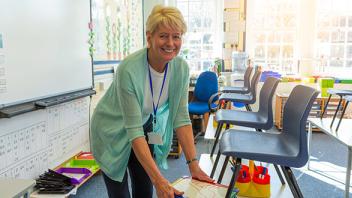Establishing a supportive classroom environment for students with autism spectrum disorder (ASD) is an important component to consider when planning and implementing instruction. Research has consistently indicated that the way the classroom environment is arranged influences the learning of individuals with ASD (Hurth, Shaw, Izeman, Whaley, & Rogers, 1999).
Additionally, research has found that students in organized and structured classrooms demonstrate more on-task behavior and higher academic achievement (Heflin & Alberto. 2001). Whether students are served in general education settings, self-contained settings, or any combination of locations, an organized classroom is key.
Why should I clean up?
Students with autism may have difficulty gaining meaning from their activities, experiences, and/or environment (Mesibov, Shea, Schopler, 2005). Participation may be limited due to a student not understanding what is expected of him/her in a specific area of the classroom or during an instructional activity. An organized classroom with defined areas and spaces can assist a student in anticipating the requirements of a specific setting and to predict what will be happening during the instructional day.
Distractibility may also be a challenge for students on the spectrum. Students may be focusing on a variety of sensations they are experiencing (i.e., sounds, sights, smells), and have difficulty prioritizing the importance of the information presented in the environment. A disorganized classroom can pull a student’s attention to irrelevant details and interrupt his/her ability to sustain focus. Providing an environment that minimizes competing distractions and is free of extraneous stimuli and clutter can assist students in attending to relevant information.
Additionally, organizational skills may be difficult for students with ASD. Gathering the required materials for a class project or packing up the necessary items to go home might be complex tasks for students, as they require a simultaneous focus on both the immediate situation, as well a focus on future and desired outcomes (Mesibov, Shea, Schopler, 2005). A disorganized classroom space may complicate the successful completion of tasks for students with ASD and inhibit a student’s ability to perform independently.
How do I clean up?
There are two key concepts to consider when organizing your classroom. The first is: Create clear physical and/or visual boundaries to help students know where each area begins and ends. Segmenting the environment helps clarify the expectations. Once students are taught expected behaviors for each space in the classroom, the distinct areas become powerful cues for appropriate behavior. Boundaries may also help communicate to younger students, or those who are impulsive or motor-driven, where each area begins and ends and where they are supposed to be/stay in the classroom during specific activities. These boundaries are not intended to “contain” students, as most of them can be easily climbed over or walked around, they are simply intended to exaggerate the cues about classroom spaces and expectations.
First, staff need to identify the different areas they would like to create in their classroom. These typically relate to what curriculum areas are addressed, the age level of the students, and what activities will occur in the classroom space. Many teachers, both in general education and special education classrooms, design areas for teacher directed activities (often individual desks), small and large group activities (i.e., small tables, carpet space on the floor), centers (i.e., reading corner, computers), and often small spaces for individual instruction or independent work if needed. Other classroom spaces may include areas to address leisure skills, vocational skills, self-help and self-management skills, and sensory development.
Next, staff needs to segment the different areas using boundaries or visual cues. The types of boundaries used may vary depending on the age of the students, the students’ familiarity with structured classrooms, the classroom setting, and the strengths and needs of individual students. Boundaries can be created with the furniture found in the classroom, such as desks, shelves, filing cabinets, or tables, as well as with teacher-created materials such as fabric, cardboard table-top dividers, or masking tape. Visual cues, like colored rugs, labels, color coding, highlighting, or placemats, are helpful in differentiating areas as well, especially locations that may be used for more than one purpose. For example, if a small group table is used for academics and also for cooking projects, staff may put a tablecloth on the table during the cooking project to help students know what to expect when they arrive at that location. Examples of a variety of boundaries used to segment classroom space are found below.
The final step is to teach students how to move through the classroom space, and what the expectations are for each segmented area. This may involve pointing out the boundaries and visual cues to students, practicing how to respond to the cues, and completing activities in each classroom space with guidance. This step also requires staff to evaluate the spaces they have designed and determine if the boundaries are meaningful for the students. If students have continued difficulty following classroom expectations, staff may decide that the organization of the classroom needs to be modified. For example, if staff has placed tape on the floor to delineate a boundary in the reading center, and the student with ASD peels off the tape and/or frequently leaves the center without being cued, staff may decide that the visual cue used is not meaningful and a bookshelf may be more appropriate.
Examples of Physical and Visual Boundaries Used to Define Classroom Areas
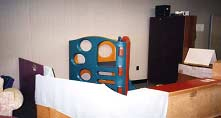 |
Shelves, cabinets, dividers, and a sheet provide physical boundaries in this gross motor play area for preschool students |
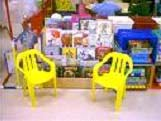 |
A bookshelf and two chairs provide the boundaries for this reading area |
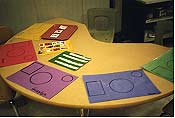 |
Colored placemats are put on the table to indicate that snack is the activity occurring at the table. The same table is used for a variety of activities throughout the day |
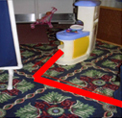 |
Masking tape on the floor provides a visual boundary in this leisure area for preschool student |
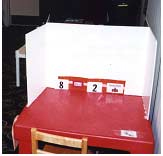 |
A table top study carrel is used to indicate when this elementary student is to complete tasks independently. It is removed when the teacher is providing instruction or the student is working with a group |
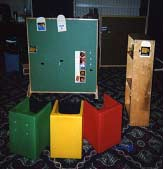 |
A rolling classroom divider, small shelf, and chairs provide physical boundaries during this language based group activity. When the activity is finished, the furniture is moved away and the area can be used for other activities |
The second key concept in organizing the classroom is to minimize auditory and visual distractions. This helps students to focus on the concepts that are being taught instead of details that may not be relevant, and reduces competing distractions. Often when students with ASD are presented with too much stimulus (visual or auditory), processing may slow down, or if overloaded, processing may stop completely. This is a natural response— consider the bulletin board used for announcements in the teacher’s lounge, church lobby, or at the grocery store. When information is presently in an orderly fashion and the space is not cluttered, we are much more likely to read and digest the information than when the board is overloaded. When papers are stacked on top of one another and the space is disorderly, we are likely to pass by the bulletin board without processing any of the information.
Minimizing distractions involves considering how much information is posted on classroom walls, and determining if what is posted is relevant to the class activity. Teachers may consider reducing the amount of stimuli in the classroom, or may decide to hang the information out of the field of vision of the most distractible students (i.e., behind the students, in a center area that doesn’t require as much attention or focus). Putting all extraneous materials and supplies in cabinets, boxes, drawers or folders is beneficial, and covering open shelves with solid colored fabric can be helpful as well. Considering sources of noise like the hallway, playground, cafeteria, bathroom, and intercom is also important when organizing classroom spaces. Similarly, visual distractions like windows, doorways, reflective surfaces, fans, computer screens, ceiling decorations, and classroom traffic should be assessed when designing the classroom space to meet the needs of a student with ASD. Often these distractions can be easily covered with butcher paper, fabric, cardboard, or the item and/or student can be moved to a better location. Examples of a variety of ways to minimize distractions in a classroom space are found below.
Examples of Strategies to Minimize Distractions in an Organized Classroom
 |
A piece of fabric rolls down to cover the contents of the shelf if needed |
 |
A sheet covers the computer screen when not in use |
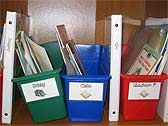 |
Extra teacher and student materials are stored in tubs and clearly labeled to reduce visual distractions |
 |
A rolling room divider can be placed in front of distracting areas, such as a doorway, bathroom entrance, or noisy group area |
Tips for cleaning up your act
- Establish organizational systems in the classroom at the beginning of the year and teach all students how to use them. Designating clear locations for specific materials such as homework, notes home, school supplies, and personal items is helpful, as well as creating routines around when and how to turn in items. A structured classroom will benefit many students, not just those on the autism spectrum.
- Organizational needs of students with ASD will vary individual by individual. Continued assessment of how the classroom environment is impacting the student’s behavior and attention will be required. Regular organizational changes may need to be made throughout the school year.
- This website has helpful ideas on organizing classroom spaces, as well as photo examples: The Virtual Vine: My Classroom
Hume, K. (2007). Clean Up Your Act! Creating an Organized Classroom Environment for Students on the Spectrum. The Reporter 13(1), 15-18.
